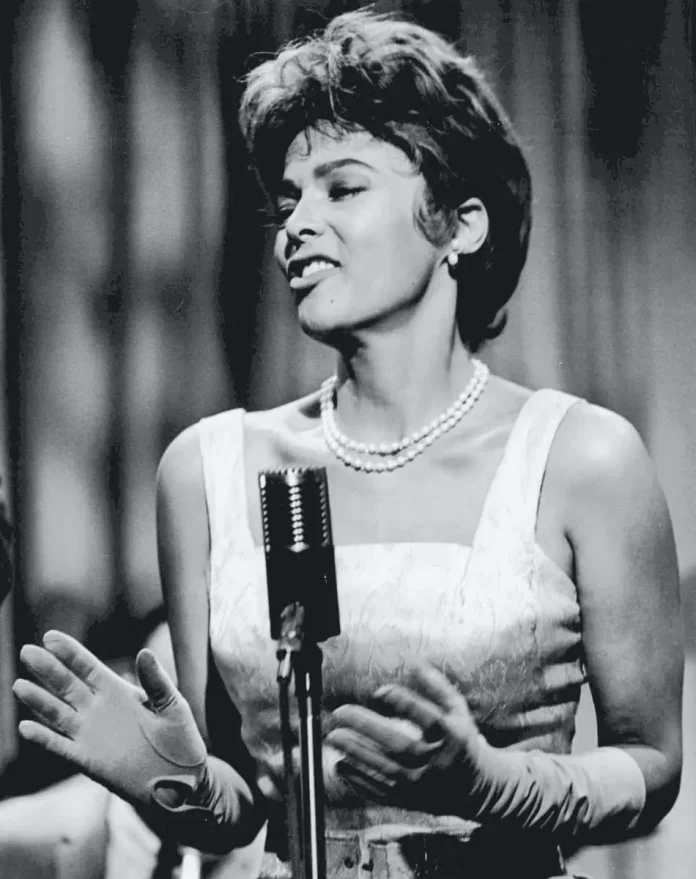It’s unlikely the perennial dilemma about what is and what isn’t jazz and who is and who isn’t a jazz singer will be resolved soon, leaving performers like Dorothy Dandridge, whose centenary falls this month, all dressed up with nowhere to go. Ironically, she shares her birth year with another “is she or isn’t she?” enigma, Judy Garland. Garland outlived her by four years, but they had in common dying in their 40s after overdosing on drugs.
For the defence I cite her gigs at the Cotton Club and Apollo Theater, the tour and the four sides she cut with the Jimmy Lunceford band, the films in which she sang with Count Basie (Hit Parade of 1943) and Louis Armstrong (Atlantic City, 1944 and Pillow To Post, 1945). These are the kind of credits lacking in Doris Day’s CV, yet an article on Day that appeared in these pages has to date attracted 12245 hits. That’s Doris Day, popular songstress – i.e., non-jazz vocalist. I rest my case.
Her life was chock-full of negatives. Her parents separated five months before her birth and she never knew her father; her mother Ruby sent her and her elder sister Vivian on the road in the care of Ruby’s disciplinarian lesbian lover who abused them both mentally and physically; her first husband left her stranded as she was about to give birth, taking the family car and going off to play golf, as a direct result of which, her only child Harolyn, was born brain-dead, unable to speak and never recognised Dorothy as her mother; in 1963, financially strapped due to drug dependency, she was obliged to confine the daughter to a state institution.
Yet Dandridge’s CV boasts several firsts: she was the first black woman to be nominated for a Best Actress Academy Award (yes, Hattie McDaniels won an Academy Award, but as Best Supporting Actress), the first black woman to appear on the cover of Life magazine and the first black entertainer to play the Empire Room at the Waldorf Astoria (this last achievement paving the way for such as Count Basie, Joe Williams, Pearl Bailey and Lena Horne).
At his trial in Athens in 399 BC, Socrates said “the unexamined life is not worth living”. A life like Dandridge’s is worth a cursory glance or even two through anyone’s microscope.
Dorothy Jean Dandridge was born in Cleveland, Ohio, 9 November 1922. Her parents, Cyril Dandridge (a cabinet maker) and his wife Ruby (who entertained in local clubs), separated shortly before Dorothy was born and Ruby was tasked with raising Dorothy and her older sister Vivian. It wasn’t long before Ruby had her two daughters working in vaudeville as “The Wonder Children” and touring the southern states on the chitlin’ circuit in the care of Ruby’s partner Geneva Williams while Ruby herself played local clubs in Cleveland.
As the Depression began to bite, Ruby moved the family to Hollywood where they met and befriended Etta Jones (no connection with the soul singer of the same name). Ruby rebranded the three of them as “The Dandridge Sisters” and launched the trio in 1934. Success came quickly at A-list venues like The Apollo Theatre and especially The Cotton Club, which first held them over and then invited them back.
It was whilst playing yet another engagement at the Cotton Club in 1940 that they shared a bill with The Nicholas Brothers, Fayard and Harold, already widely regarded as the finest tap dancers in the world. Two years later the brothers worked with Dorothy again in the Chattanooga Choo-Choo segment of the film Sun Valley Serenade, the first of two feature films featuring Glenn Miller and his orchestra, and Harold and Dorothy were married 6 September 1942.
The marriage was unhappy from the start with Harold making no real effort to settle down. Almost one year later, 2 September 1943, Harold took the family car and went to play golf as Dorothy went into labour with what would be her only child. As a result of the delay in getting to the hospital, the child, a daughter, was born with brain damage, unable to speak and never able to recognise Dorothy as her mother.
Dorothy continued to work in order to pay the large medical bills in respect of her daughter’s care, and her divorce was finalised in 1951. She headlined in major nightclubs on both coasts and played international venues like The London Palladium. Her big break came in 1954 when she won the lead in the film adaptation of Oscar Hammerstein’s stage show Carmen Jones, opposite Harry Belafonte. The director was Otto Preminger and he and Dorothy embarked on a four-year affair during which she aborted his child when it became clear he had no intention of leaving his wife.
Something of a control freak, Preminger virtually forbade her to turn down anything less than a leading role, resulting in her missing out on prestigious smaller parts such as Tuptim in The King And I. She had one more decent role, again opposite Belafonte in the film version of Porgy And Bess, after which the roles began to dry up. By 1963 she could no longer afford to pay the medical bills for her daughter and was obliged to put her in a state institution.
She struggled on for another couple of years but on 8 September 1965, aged 42, Dorothy Dandridge was found dead in her apartment in Hollywood. At her death she had $2 in her bank account. The unexamined life – in spades.
















